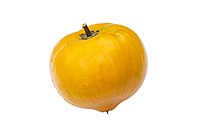Egg fruit


The egg fruit tree is approximately 8 meters tall and has oblong fruits that range from 7 to 12 centimeters in length. The fruits can vary in shape. Some have a straight point at the end and can be curved at the tip. When ripe, the egg fruit looks golden-orange and occasionally exhibits rusty brown blotches, which is normal for this plant. The interior is similar to both the color and texture of a hard-boiled egg yolk, hence the name, and contains 1-4 hard black seeds. Ripe egg fruit flows a strong musky smell.[1]
Seasons/availability
[change | change source]Egg fruit is available in fall, into summer in tropical climates.
Terminology
[change | change source]Egg fruit is commonly referred to as canistel and botanically classified as Pouteria campechiana. It is a member of the Sapotaceae Family and a close relative of the more popular tropical fruit, Sapota. Egg fruit is also sometimes referred to as yellow sapote. Egg fruit gets its name from the consistency of its flesh. When ripe, the egg fruit is said to resemble a hard-boiled egg yolk with the flavors of roasted sweet potato.
Nutritional value
[change | change source]Egg fruit is rich in vitamin A, B, and C, and also contains iron and calcium.
Applications
[change | change source]Egg fruit is often eaten raw as a simple snack with a sprinkle of salt and lemon juice. It is also used in sweet baking applications as a pumpkin-like ingredient. The pureed flesh may be added into custards, ice creams, bread, pancakes, smoothies, milkshakes or made into jams and marmalades. The egg fruit is a central ingredient in recipes for vegan cheesecake, eggnog, deviled eggs, and even cheese. Complimentary flavors include allspice, cinnamon, ginger, thyme, turmeric, orange, maple syrup, pecans, walnuts, almond, coconut, and vanilla.
Geography/history
[change | change source]The Egg fruit is native to southern North America and northern Central America, including the countries of Mexico, El Salvador, Belize, and Guatemala. It has since been naturalized throughout the world in tropical and subtropical climates. The trees thrive with moderate precipitation, but can also do well in regions of prolonged dry seasons. This fruit was also known for its smelly seeds.
References
[change | change source]- ↑ "Canistel facts and health benefits". 2019-06-26. Retrieved 2022-03-29.
